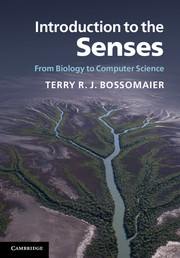Book contents
- Frontmatter
- Contents
- Foreword
- Acknowledgements
- 1 Introduction and overview
- 2 Understanding sensory systems
- 3 Introduction to Fourier theory
- 4 Introduction to information theory
- 5 Hearing
- 6 Basic strategies of vision
- 7 The correspondence problem: stereoscopic vision, binaural hearing and movement
- 8 The properties of surfaces: colour and texture
- 9 The chemical senses
- 10 The somatosensory system
- 11 Non-human sensory systems
- 12 Sensory integration
- References
- Index
- Plate section
9 - The chemical senses
Published online by Cambridge University Press: 05 July 2012
- Frontmatter
- Contents
- Foreword
- Acknowledgements
- 1 Introduction and overview
- 2 Understanding sensory systems
- 3 Introduction to Fourier theory
- 4 Introduction to information theory
- 5 Hearing
- 6 Basic strategies of vision
- 7 The correspondence problem: stereoscopic vision, binaural hearing and movement
- 8 The properties of surfaces: colour and texture
- 9 The chemical senses
- 10 The somatosensory system
- 11 Non-human sensory systems
- 12 Sensory integration
- References
- Index
- Plate section
Summary
Nothing revives the past so completely as a smell that was once associated with it.
Vladimir NabokovIntroduction
The importance of the chemical senses varies throughout the animal kingdom. Humans are dominated by audiovisual stimuli. Not only is this reflected in the amount of brain capacity devoted to chemical senses, but it is also reflected in language. In a wide-ranging study of languages across the globe, two-thirds to three-quarters of words denote sensory experience or function referring to hearing or vision (Wilson, 1998).
We think of our senses as quite distinct, although there are cross-over effects, referred to as synaesthesia. People with synaesthesia get strong percepts of another sense from the stimulus of one. Thus a particular smell or musical tone may invoke a distinct colour (§12.3.2).
Chemical senses are at their most developed in olfaction, yet there are chemical sensors throughout the skin and internal organs. In fact chemical sensing might be considered the first to evolve of all the senses, being present in simple unicellular organisms such as bacteria and protozoans. Some are able to sense and move along chemical gradients. Taste and smell have obvious similarities and synergies, but the detector systems are not confined to the tongue and nose. Even bacteria emit a range of chemicals which impact across eukayrotes, plants, fungi and animals (Dunkel et al., 2009).
Our subjective experience of smell tends to be one of gathering environmental information. Think how different it is for many other mammals. Think about how dogs sniff each other when they meet. Think about the way cats are dominated by the smells in their territory, particularly the highly specific urine markers of other cats. There is another lifestyle out there, a lifestyle in which molecules, semiomolecules, are synthesised to be passed by one animal or plant to another as a signal. It might be a signal to mate, a signal that fruit is ripe and ready to eat, a signal of where other members of the group have found food.
- Type
- Chapter
- Information
- Introduction to the SensesFrom Biology to Computer Science, pp. 218 - 245Publisher: Cambridge University PressPrint publication year: 2012

